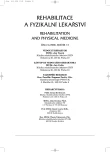Modulation of Cardiovascular Functions Due to Repeated Coolings of Lower Legs
MODULACE KARDIOVASKULÁRNÍCH FUNKCÍ PO OPAKOVANÉM OCHLAZOVÁNÍ DOLNÍCH KONČETIN
Ponoření nohou do studené vody (14 °C) vyvolává malou, ale soustavnou aktivaci sympatického nervového systému, což se projevuje zrychlením srdečního tepu a periferní vazokonstrikcí. Nastává také přesun krve z periferie do centra těla. Chladová adaptace, vyvolaná opakovanou lokální imerzí, připomínající Priessnitzovy procedury, snižuje srdeční frekvenci, což ukazuje na redukci sympatického tonu a současně zvyšuje periferní vazokonstrikci, což naznačuje aktivaci sympatického tonu. Chladová adaptace tedy vyvolává různou odpověď různých orgánů kardiovaskulárního systému. Lokální chladová adaptace vyvolává jiné fyziologické odpovědi než celotělová adaptace.
Klíčová slova:
chladová adaptace, kardiovaskulární systémy, dolní končetiny, Priessnitzovy procedury
Authors:
D. Jandová 1; L. Janský 2; P. Janský 3; V. Vávra 2
Authors‘ workplace:
Priessnitzovy léčebné lázně, Jeseník
1; Biologická fakulta Jihočeské univerzity, České Budějovice
2; 2. lékařská fakulta Univerzity Karlovy, Praha
3
Published in:
Rehabil. fyz. Lék., 13, 2006, No. 2, pp. 71-73.
Category:
Original Papers
Overview
Immersion of lower legs into cold water (14 °C) induces a small, but sustained activation of the sympathetic nervous systém, which manifests as tachycardia and peripheral vasoconstriction. Blood is shiftedd from the body periphery to the central areas of the body. Cold adaptation, induced by repeated local cold water immersions, lower heart rtate, which indicates lowering of the sympatheric tone, but increases vacoconstriction, which indicates activation of the sympathetic tone. Local cold adaptation induces different physiological resposes that the whole body cold adaptation.
Key words:
cold adaptation, casdiovascular systém, lower legs, Priessnitz procedures
Labels
Physiotherapist, university degree Rehabilitation Sports medicineArticle was published in
Rehabilitation & Physical Medicine

2006 Issue 2
- Hope Awakens with Early Diagnosis of Parkinson's Disease Based on Skin Odor
- Deep stimulation of the globus pallidus improved clinical symptoms in a patient with refractory parkinsonism and genetic mutation
Most read in this issue
- Relationship betweem Breathing Movements and Posture
- Disorders of Cervicothoracic Junction and Distant Symptoms
- New Knowledge about Structural Prerequisites in Coordination of the Diaphram Function and Belly Muscles
- Shoulder Girdle in the Regiment of Quadrupedal Locomotion
